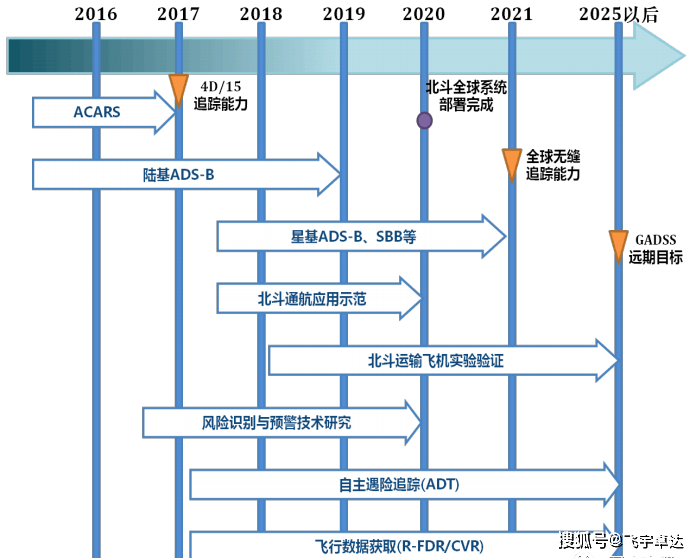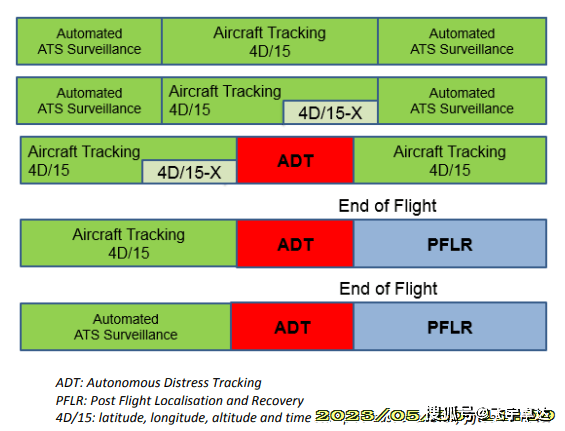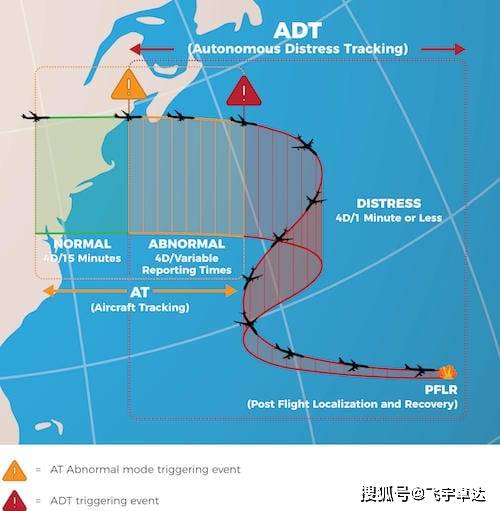國際民航組織(ICAO)作為聯合國的專門機構,主要因應AF447和MH370航班失蹤事件而建立了全球航空遇險和安全系統(GADSS)。GADSS包含的標準和建議措施(SARP)規定了航空公司和飛機運營商在正常情況下以及飛機遇險時的飛機跟蹤要求。
GADSS起源和推進情況自2014年3月8日馬航MH370航班發生失聯事件后,國際民航組織(ICAO)充分吸取事件本身所暴露出的安全隱患,即看似配置了多種類型高技術含量地空監視手段的現代大型飛機,實際上缺乏一種自動、自主、不受第三方影響的的地空實時險情報告手段,導致飛機遇險時地面不容易得到實時準確的情況報告。此外,當前地面對飛機的監控主要依靠雷達,但雷達覆蓋范圍一般為從海岸向外延伸350公里左右。這意味著,當飛機在跨海飛行或者在偏遠地區飛行時,由于信號覆蓋不到而無法被地面控制中心掌控精確位置和實際運行狀態。一旦發生意外情況,定位和搜救將十分困難
馬來西亞航空公司MH370客機失聯事件促使人們開始關注如何全程追蹤一架飛機,我們該如何保障一架飛機"看得見,聽得到,管得住"。為此,近年來,世界航空界大力開展自主的全球范圍內航空器監控工作,從而啟動了全球飛機遇險跟蹤系統(GADSS)的相關工作。
GADSS系統的基本理念是通過發送遇險信號來應對諸如通信系統被非法侵入的挑戰,該遇險信號的發送獨立于其他機載系統,當飛機飛行高度、速度等出現異常或動力系統失靈等特殊情況時候,該系統基于特定的觸發規則就會自動發送信號,從而實現 “危險自動跟蹤”(ADT)信號的要求當飛機進入異常狀態時,由飛機上獨立的系統自動的按照一定的時間間隔,周期性的報告飛機經緯度等必要信息。ICAO 于2016年3月起正式實施這些改進意見,并增加了新的標準和推薦措施(SARP)。
正常的飛機跟蹤SARP從2018年11月開始生效,其中規定,航空運營人有責任在其整個運行區域內對其飛機進行跟蹤。在無法通過空中交通服務進行跟蹤時,運營商應至少每15分鐘收到一次飛機位置。與遇險飛機位置有關的SARP將于2021年1月生效,其中要求對遇險飛機進行自動跟蹤,并且每分鐘應至少更新一次位置。
2017 年 7 月,中國民用航空局發布了《中國民航航空器追蹤監控體系建設實施路線圖》。

飛機通信尋址與報告系統(ACARS)可以在航空器和地面用戶之間通過甚高頻、高頻或衛星數據鏈傳輸報文,實時掌握飛機的空中情況。相比ACARS技術,廣播式自動相關監視(ADS-B)具有更強的實時數據傳輸能力。隨著航天技術的成熟與商業小衛星的成本降低,采用星基手段開展空管應用逐漸具備了可行性。未來,星基ADS-B衛星系統將有效解決陸基地面站覆蓋能力不足的問題,成為空管系統的重要組成部分。
GADSS的關鍵組成部分如下圖:

AT:正常運行期間的飛機跟蹤——飛機位置信息需要至少每15分鐘更新一次,并可用于空中交通服務(ATS)。
ADT:非正常操作期間的自主遇險跟蹤(ADT)-當飛機處于遇險狀態時,飛機位置信息將至少每分鐘傳輸一次,無需機組人員采取行動。
PFLR:飛行后的定位和數據恢復-向SAR服務提供準確的飛機位置信息(1海里精度或更好)。
Concept
According to the ICAO Concept of Operations, the Global Aeronautical Distress and Safety System (GADSS) will address all phases of flight under all circumstances including distress. This GADSS will maintain an up‐to‐date record of the aircraft progress and, in case of a crash, forced landing or ditching, the location of survivors, the aircraft and recoverable flight data.
The three main functions of the GDASS are:
Aircraft Tracking
The GDASS Aircraft Tracking function is planned to provide an automated 4 dimensional position (latitude, longitude, altitude and time) at a reporting interval of 15 minutes or less. This reporting interval will result in a reduction of the time necessary to resolve the status of an aircraft or, when necessary, help to locate an aircraft. If air traffic services obtain an aircraft position at 15 minute intervals or less, it will not be necessary for the operator to track the aircraft. However, should the aircraft be operating within an area where ATS obtains the aircraft position at intervals greater than 15 minutes, the operator will be required to ensure that the aircraft is tracked.
In general terms the aircraft tracking function:
Autonomous Distress Tracking
The Autonomous Distress Tracking (ADT) function will be used to identify the location of an aircraft in distress with the aim of establishing the location of an accident site within a 6 NM radius. An aircraft is considered to be in a distress condition when it is in a state that, if the aircraft event is left uncorrected, may result in an accident. Triggering criteria might include items such as unusual attitudes, altitudes or speeds, potential collision with terrain, total loss of thrust on all engines, Mode A squawk codes, and others as defined by the operator.
The ADT function will use on-board systems to broadcast either aircraft position (latitude and longitude), or a distinctive distress signal from which the aircraft position and time can be derived. Once the ADT has been triggered by a distress condition event, the aircraft position information will be transmitted at least once every minute.
Post Flight Localization and Recovery
In the event of an accident, the immediate priority is the rescue of any survivors. The ADT function will greatly reduce the potential search area and even more accurate aircraft position information will be provided through the Post Flight Localization function by means of Emergency Locator Transmitter (ELT) and/or homing signals to guide SAR services on site.
To facilitate the ability to locate the wreckage and recover the flight recorder data after an accident, the post flight localization and recovery function specifies a number of requirements for ELTs, Underwater Locator Beacon (ULB) and flight recorders which are being incorporated into the provisions of ICAO


